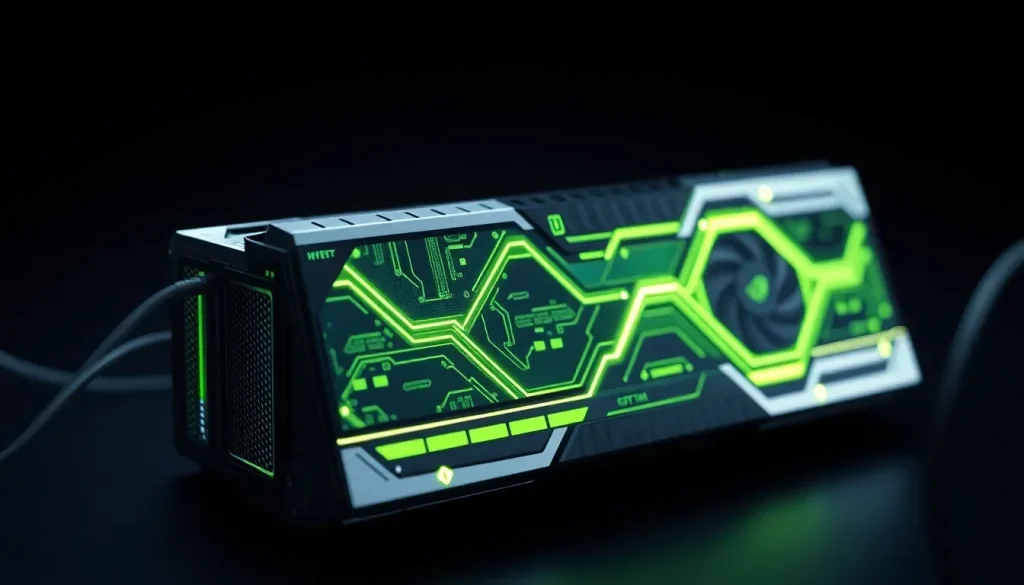NVIDIA AI GPU Performance Boost for Quick Payback, Says Phononic CPO

As the demand for AI technology surges, the necessity for advanced cooling solutions has become increasingly critical. NVIDIA's latest AI GPUs have prompted discussions about the efficiency and performance of these powerful chips, particularly regarding their cooling requirements. In this exploration, we uncover insights from Larry Yang, Chief Product Officer at Phononic, about the evolving landscape of GPU cooling technology.
- Understanding the Cooling Needs of NVIDIA's AI GPUs
- Traditional Cooling Technologies vs. Modern Solutions
- Innovations in Cooling Technology Amid the AI Boom
- The Impact of New GPU Architectures on Cooling Requirements
- Enhancing GPU Performance with Thermoelectric Cooling
- The Role of ASICs in the Evolving Cooling Landscape
- Phononic's Innovative Cooling Solutions Explained
- Future Trends in Data Center Cooling
Understanding the Cooling Needs of NVIDIA's AI GPUs
NVIDIA recently launched its Rubin AI GPUs, a significant advancement in the realm of artificial intelligence. To better grasp the implications of these new chips, we engaged in a conversation with Larry Yang, whose extensive background in the tech industry spans over three decades and includes roles at major companies like Google, IBM, and Microsoft.
During our discussion, we focused on the cooling requirements of NVIDIA's AI chips, particularly how they relate to energy efficiency. Yang emphasized that the need for effective cooling solutions is largely driven by the use of high bandwidth memory (HBM) chips, which generate substantial heat during operation.
Phononic’s innovative thermoelectric coolers (TECs) are designed to improve the cooling process, allowing AI companies to extract greater performance from each GPU. This leads to increased efficiency and potentially lowers the need for additional GPUs.
Traditional Cooling Technologies vs. Modern Solutions
To contextualize the advancements in cooling technology, Yang explained the traditional methods currently in use. Historically, cooling systems relied on air-cooled techniques, where air is blown across heat sinks made from materials like aluminum or copper.
- Heat Sinks: The basic principle involves creating a large surface area for air to absorb heat.
- Liquid Cooling: As heat density increased, liquid cooling emerged as a more efficient alternative, particularly in supercomputing and specialized applications.
- Current Trends: With AI processors generating more heat, liquid cooling is becoming prevalent across the industry.
Yang pointed out that while liquid cooling has been utilized for decades, its adoption for AI processors is accelerating, and companies are turning to more efficient methods to manage heat.
Innovations in Cooling Technology Amid the AI Boom
Since the onset of the AI surge in late 2022, the cooling industry has witnessed a wave of innovation. Yang noted that many companies are exploring unconventional solutions to address the urgent cooling needs of data centers. For instance:
- Underwater Data Centers: Some firms have experimented with submerging data centers underwater to stabilize operating temperatures.
- Underground Facilities: Other data centers have opted for underground installations, leveraging cooler ground temperatures.
- Space-Based Data Centers: Startups are even considering launching data centers into space to utilize the coldness of the cosmos.
These inventive approaches reflect the industry's response to increasing heat challenges and the necessity for efficient cooling solutions. Yang highlighted the limitations of mechanical cooling systems, which often lead to data centers being overcooled. He advocates for solid-state systems that can target specific hotspots, enhancing energy efficiency and reducing overall cooling costs.
The Impact of New GPU Architectures on Cooling Requirements
With the introduction of NVIDIA’s Blackwell GPUs, changes in cooling demands have become evident. Yang observed a noticeable shift in the industry's enthusiasm for liquid cooling due to the high heat densities associated with these chips.
For example, the Blackwell B200 NVL72 rack can reach power outputs of around 120 kilowatts, comparable to the heat generated by multiple Weber grills in a confined space. Such demands necessitate advanced cooling strategies, particularly for components like high bandwidth memory chips, which generate significant heat.
Understanding the intricacies of these memory chips is crucial. They are designed to facilitate rapid data transfer to and from the processing core. However, as Yang explained, the configuration of HBM stacks creates thermal challenges that can throttle performance if not managed properly. Phononic aims to address these issues by implementing targeted cooling solutions that enhance GPU performance without compromising energy efficiency.
Enhancing GPU Performance with Thermoelectric Cooling
As the Rubin AI GPUs roll out, Yang indicated that they would continue to rely on traditional liquid cooling methods. However, Phononic's technology is positioned to optimize this existing infrastructure. By using TECs to cool the high bandwidth memory directly, the company aims to unlock greater performance from the GPUs.
Yang estimated that companies investing in Phononic's thermoelectric cooling solutions could see a payback period of just a few months due to the increased performance and efficiency these systems offer. This approach helps avoid the costly necessity of purchasing additional GPUs, making it an economically viable option for firms looking to maximize their AI capabilities.
The Role of ASICs in the Evolving Cooling Landscape
With the growing interest in custom ASIC AI chips, Yang noted that cooling requirements are becoming a critical factor influencing the demand for these specialized processors. Similar thermal challenges arise in networking ASICs, which also require effective cooling solutions to optimize performance.
As companies like NVIDIA, AMD, and others continue to develop AI accelerators that integrate high bandwidth memory, the need for precise cooling technologies becomes increasingly imperative. This is where Phononic’s thermoelectric solutions come into play, offering targeted cooling that can significantly enhance the performance of these chips.
Phononic's Innovative Cooling Solutions Explained
Phononic's cooling technology is rooted in the thermoelectric principle, which utilizes specific materials to create temperature gradients when an electric current is applied. The company has successfully integrated this technology into various applications, including cooling lasers and optical transceivers for data centers.
The TECs are strategically placed between traditional liquid cooling systems and the memory chips, providing an additional layer of cooling. This setup allows for remote temperature monitoring and adjustments, optimizing cooling based on real-time requirements. Key features of Phononic's solutions include:
- Solid-State Technology: No moving parts, allowing for faster response times and increased reliability.
- Temperature Control: Local electronics monitor temperatures and adjust cooling dynamically.
- Energy Efficiency: TECs operate only when needed, reducing overall energy consumption.
Future Trends in Data Center Cooling
As AI demand continues to grow and chip designs evolve, Yang believes the data center cooling industry must adapt to meet these challenges. He anticipates that as new technologies are adopted, the cooling solutions will also need to advance.
Innovative concepts are already emerging, such as the incorporation of microfluidic channels within memory stacks to enhance cooling efficiency. Phononic is exploring ways to integrate their thermoelectric technology directly with silicon to streamline cooling processes.
The evolution of cooling technologies will be crucial to the success of AI applications, particularly as processors become more powerful and generate more heat. Addressing these challenges proactively will empower data centers to maintain optimal performance while managing energy use effectively.
For further insights into the intersection of AI and cooling technology, check out this enlightening video:




Leave a Reply